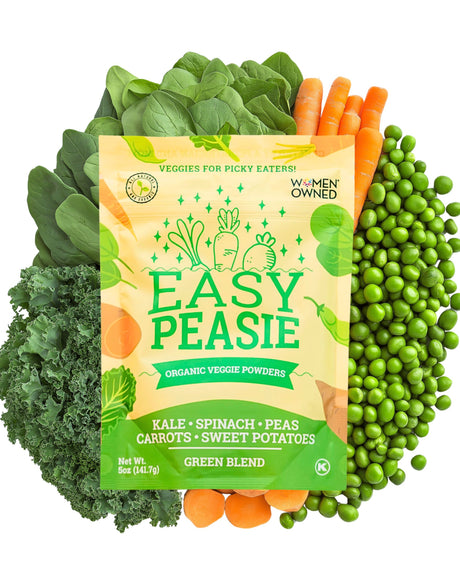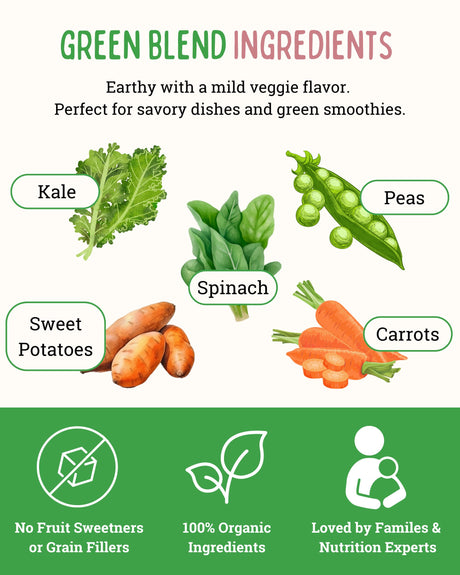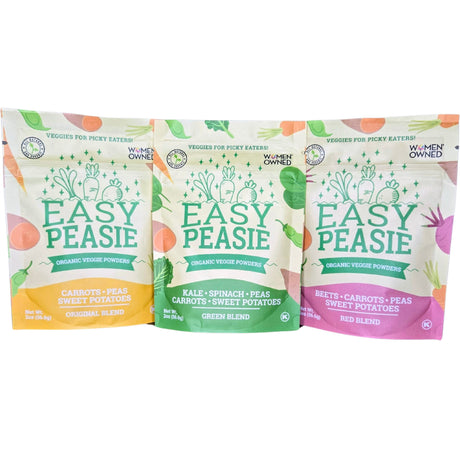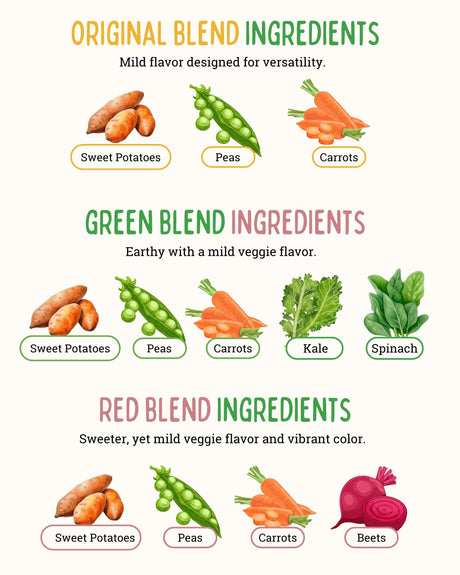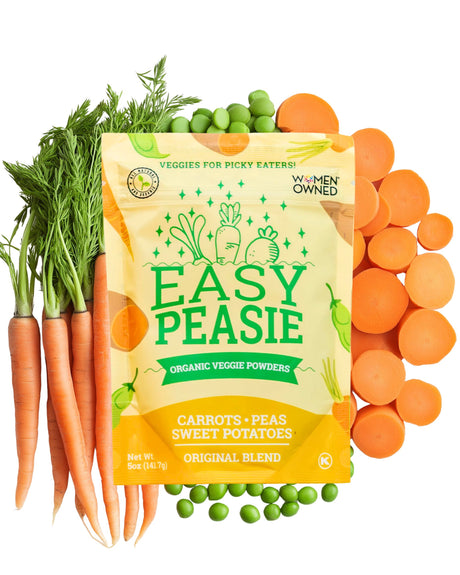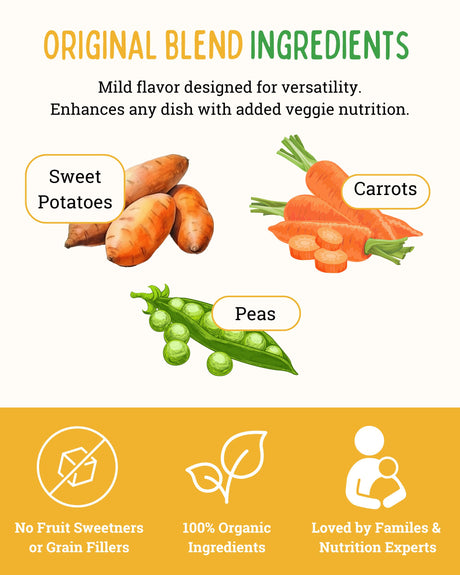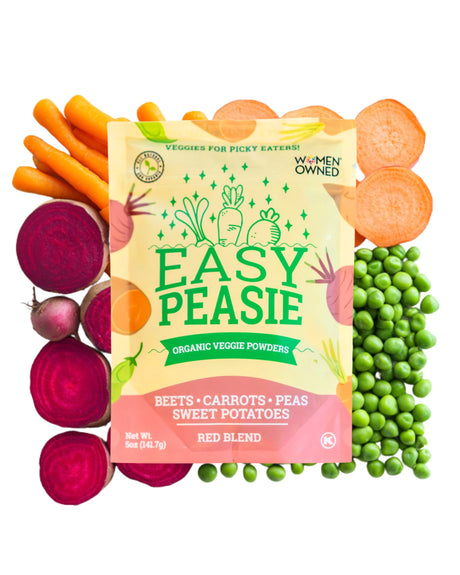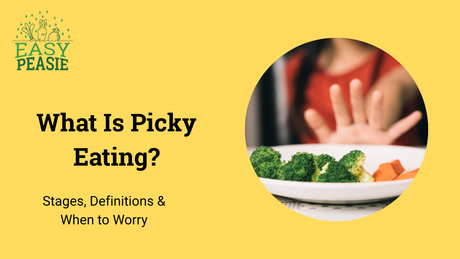Nutrition for Kids
When it comes to our little ones, proper nutrition is one of the best ways to ensure healthy growth, strong bones, and active minds. Vegetables play a starring role in childhood development, offering vital nutrients like vitamins, minerals, and fiber that help build strong bodies and support cognitive development.
But let’s face it—getting kids to eat their veggies can be a struggle! That's where finding creative solutions to boost nutrition, like green powders, comes in handy.
In this blog, we’ll dive into the comparison between green powders and fresh vegetables. We’ll explore the nutritional benefits of both, discuss whether green powders can really replace whole veggies, and share tips on how to incorporate these nutrient-packed options into your child's meals.
Whether you're a fan of fresh produce or curious about the convenience of green powders, we’ve got everything you need to make the best choice for your family!
What Are Green Powders?
Understanding Green Powder
Green powders are a concentrated blend of nutrient-packed superfoods, often made by drying and grinding vegetables, fruits, and other plant-based ingredients into a fine powder. They’re designed to give you a quick dose of essential nutrients in a convenient form.
Common Ingredients in Green Powders
You’ll often find a mix of kale, spinach, spirulina, wheatgrass, and chlorella in many green powders. Some blends also include antioxidant-rich fruits, digestive enzymes, and probiotics, making them a powerful nutrient boost in just one scoop.
Why Parents Choose Green Powders
Parents may opt for green powders for a variety of reasons. If you have a picky eater who turns their nose up at anything green, adding a scoop of powder to a smoothie or sauce can be an easy way to sneak in those missing veggies. The convenience factor is also a big plus—no washing, chopping, or cooking required!
The Benefits of Fresh Vegetables
Nutritional Powerhouses
Fresh vegetables are nature’s original superfoods, offering an abundance of essential vitamins and minerals like vitamin A, C, potassium, and magnesium. Not to mention, they’re an excellent source of fiber, which is key for healthy digestion.
Health Benefits of Fresh Veggies for Kids
From improving digestion to boosting immunity, fresh vegetables help support all the critical systems in your child’s body. Kids who eat a variety of veggies regularly are likely to enjoy better energy levels, stronger bones, and healthier skin.
Variety and Freshness
One of the greatest advantages of fresh vegetables is the variety they offer. Seasonal produce like carrots in the winter or cucumbers in the summer brings different textures and flavors to the table while ensuring a diverse range of nutrients in your child’s diet.
Nutrition Comparison – Green Powder vs. Fresh Vegetables
Key Nutrients in Fresh Vegetables
Fresh vegetables are loaded with essential nutrients like vitamins A and C, which help keep your child’s immune system strong, and fiber, which supports digestion and overall gut health. You’ll also find antioxidants that help fight off free radicals and inflammation in fresh veggies.
Nutrients Found in Green Powder
Green powders pack a punch in terms of nutrient density, delivering concentrated amounts of vitamins, minerals, and antioxidants. While these powders can provide a substantial amount of nutrients in one serving, it’s important to consider whether they match the nutritional diversity and balance found in whole vegetables.
Absorption and Bioavailability
The body absorbs nutrients differently from fresh produce and powdered forms. Fresh veggies come with water, fiber, and enzymes that help the body digest and absorb nutrients more effectively. Green powders may be nutrient-rich, but they often lack the fiber and hydration naturally present in fresh vegetables, which can impact how well certain nutrients are absorbed.
Are Green Powders Safe for Kids?
Safety Concerns for Green Powders
Green powders are generally safe for children, especially when made from clean, natural ingredients, but they should not be a complete substitute for fresh vegetables.
Whole vegetables provide essential fiber, which is key for digestion and gut health, and their variety of textures helps develop chewing skills and exposes kids to a broader range of flavors.
While green powders are convenient for boosting nutrition on busy days or for picky eaters, it's important to balance them with fresh produce to ensure your child gets the full spectrum of nutrients. For best results, use green powders as a supplement to an already balanced diet, not as a replacement.
Potential Allergens or Additives
Parents should be especially cautious about certain ingredients in green powders that may not be suitable for children. Some brands include added sugars, artificial preservatives, or flavor enhancers, which can undermine the health benefits. Additionally, allergens like soy, nuts, or gluten may be present, which can pose risks for children with food sensitivities or allergies.
It's crucial to thoroughly check the ingredient list and choose powders that are free from unnecessary additives, fillers, or potential allergens. Opt for organic or clean-label products specifically formulated for kids to ensure safety and quality tailored to their dietary needs.
Recommended Dosages for Kids
When introducing green powders to your child, starting with a small, age-appropriate serving is key to ensuring they tolerate it well. Typically, a child-sized serving is about half the recommended adult dose, but this can vary depending on the brand and specific ingredients. Always follow the manufacturer’s guidelines to avoid overconsumption of certain nutrients, which can sometimes lead to digestive discomfort or other issues.
It's also wise to gradually increase the amount, giving your child time to adjust to the new flavors and ingredients. Before adding green powders to your child’s daily routine, consulting your pediatrician is highly recommended to ensure the product aligns with your child’s nutritional needs and health profile. This is particularly important if your child has allergies, dietary restrictions, or other health concerns.
Pros and Cons of Green Powder for Kids
Pros of Green Powder
Green powders can be a lifesaver for busy families, especially on hectic days when getting enough veggies into meals feels impossible. They’re also great for boosting nutrition in picky eaters who resist anything green, as you can easily mix green powder into their meals without the fuss. Whether blended into smoothies, muffins, or even pancakes, green powders make it simple to sneak in extra nutrients.
However, there are some drawbacks. Unlike fresh veggies, green powders lack the texture and satisfaction that come from the crunch and variety of whole vegetables. Additionally, some brands may contain added fillers or sweeteners, reducing the overall health benefits.
And while green powders are convenient, they provide less fiber compared to whole vegetables, which are essential for healthy digestion and promoting a feeling of fullness.
When Fresh Vegetables Are Better
Whole Foods Are Always Best
While green powders are a great supplement, fresh vegetables should always be the first choice. Whole veggies provide a complete package of nutrients, fiber, water, and natural enzymes that powders simply can’t replicate.
Incorporating Fresh Vegetables Daily
If you’re struggling to get fresh veggies on your child’s plate, try sneaking them into familiar dishes. Puree vegetables into sauces, add them to smoothies, or bake them into muffins. Making vegetables fun—like creating rainbow veggie platters—can also help make them more appealing.
Teaching Kids to Love Veggies
Getting kids to embrace whole vegetables can take time, but involving them in meal prep can make a big difference. Let them help wash or chop veggies or choose their favorite produce at the grocery store. When kids feel connected to their food, they’re more likely to eat it!
How to Add Green Powder to Your Kids’ Meals
Adding Green Powder to Meals
Green powders are incredibly versatile. Stir them into smoothies, pancake batter, pasta sauces, or even mix them into scrambled eggs. Just be sure to blend them well so the flavor stays hidden and the texture remains smooth.
Using Green Powder as a Supplement, Not a Substitute
It’s important to remember that green powder is a supplement—not a substitute for whole vegetables. Use it to fill in nutritional gaps but always strive to serve fresh veggies in your child’s daily meals to ensure they get the full spectrum of benefits.
This practical guide helps parents navigate the balance between fresh vegetables and green powder supplements, offering tips to boost their child’s nutrition while ensuring whole foods remain the primary source of goodness.
Fresh Vegetables vs. Green Powder for Picky Eaters
For Picky Eaters: How Green Powder Can Help
For kids who consistently resist vegetables, green powder can be a helpful tool to fill nutritional gaps. It’s a quick and convenient way to ensure your child gets essential vitamins and minerals when they refuse fresh veggies. While it doesn’t replace whole vegetables, it’s a great supplement for those tough mealtime battles.
Creative Ways to Serve Veggies and Green Powder
Getting creative is key when introducing both fresh veggies and green powder into your child’s diet. Try adding green powder to baked goods like muffins, pancakes, or even waffles.
You can also blend fresh spinach or kale into smoothies with bananas and berries for a tasty, nutrient-packed drink. Mixing green powder into sauces or soups is another sneaky way to boost nutrition without your picky eater noticing.
Encouraging Picky Eaters to Try New Veggies
Green powders can help bridge the nutritional gap for picky eaters, but it’s still essential to introduce your child to fresh vegetables regularly. Fresh veggies provide important fiber, texture, and the full range of nutrients that powders can’t always match. Start small by offering familiar vegetables like carrots or cucumbers alongside your child’s favorite meals to make the transition less daunting.
Boosting Nutrition with Both Fresh Veggies and Green Powders
Finding the Right Balance
Combining fresh vegetables with green powder can provide a balanced approach to nutrition. Fresh veggies deliver fiber, water content, and a variety of textures, while green powders offer concentrated nutrients. Together, they create a well-rounded diet that covers the bases without sacrificing convenience.
Planning Meals with Both
When planning meals, try incorporating both fresh vegetables and green powder. For example, you can serve a salad packed with fresh greens, cucumbers, and tomatoes while adding a scoop of green powder to a smoothie or soup for extra nutrients. This ensures that your child gets a good mix of textures, flavors, and nutrients in one sitting.
Gradually Introducing Green Powders
Introducing green powders into your child’s meals can be as simple as starting with a small scoop mixed into familiar foods like yogurt or applesauce. Gradually increase the amount as they become more accustomed to the flavor. If they’re sensitive to new tastes, blend it into a smoothie with sweet fruits like bananas or berries to mask the green powder’s taste.
Summary
Both fresh vegetables and greens powder have their own benefits. Fresh veggies provide natural fiber, texture, and hydration, while green powders offer convenience and a concentrated nutrient boost. Neither can completely replace the other, but together they help ensure your child gets the nutrition they need.
A balanced approach that includes both fresh vegetables and green powder allows you to meet your child’s nutritional needs while navigating picky eating habits. Variety is key—experiment with different vegetables, preparation methods, and sneaky ways to add nutrition.
Now that you have the tools to boost your child’s nutrition, give these tips a try! Share your favorite sneaky veggie recipes with us, follow Easy Peasie on social media (Facebook, Instagram, and YouTube) for more ideas, and explore additional resources to keep your family’s meals fun and nutritious.


